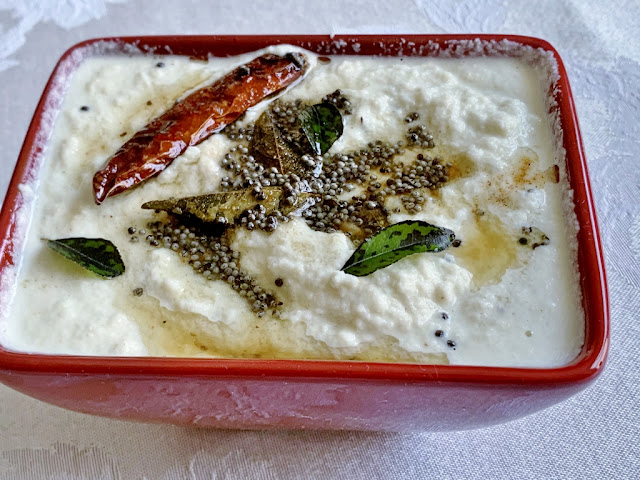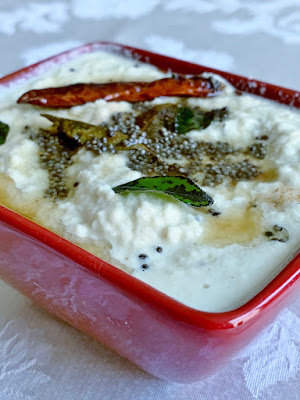 |
| Nariyal Chutney or Coconut Chutney |
At the time I first attempted making a coconut chutney, I was living in South Dakota. Having an Indian Grocery store (or even an Indian restaurant) was only a fond wish, the closest being in Sioux Falls, 3½ hours away. Yes, the local grocery did have "fresh" coconuts. Heaven only knew how fresh that may have been. I also had no desire to make a huge mess trying to open up a coconut and work at scraping the "meat" out. And so it happened that when I finally decided to give Coconut Chutney a try, I opted to use grated, dry, unsweetened coconut.
To be clear, to date, I had not ever even LIKED coconut chutney. No matter where I had tried it, no matter how many times, it was always just bland and blah. And this is just ridiculous, because I LOVE coconut!
I plowed ahead with making a chutney from the dry coconut, soaking it first in an effort to bring it back to some semblance of fresh. Not. Didn't happen. I read countless coconut chutney recipes before even starting to cobble together my own recipe, and while most said to use fresh coconut for best results, they also stated that dried could be used.
My resulting chutney was okay. Maybe better than the ones I'd eaten in Indian restaurants, but still not something great. I figured that since at least it tasted better than anything I had eaten to date, that it was good enough to post in my blog. But. I hadn't gone back to try it again. It was uninspiring. I think, if ever I did go back and use dried coconut, I might alter a couple of things. For example, I only had a jalapeno pepper in the fridge at the time so that went in. And the chutney was greenish. Not an awful thing, for sure, though not at all like all the pretty photos of pristine white chutney I had seen online. Later on I read that using a thinner fleshed green chili pepper is wiser, as it adds less green color.
 |
| Nariyal (Coconut) Chutney II |
Altogether, while that chutney was okay in a pinch, now, with an Indian grocery far more accessible, and with fresh grated coconut in the frozen section, I figured I might just have to rethink the whole idea.
Not too many changes . . .
Truly, once I got down to looking at the recipe I had originally created, and despite re-reading probably 15 or more different blogs on coconut chutney, I couldn't come up with much to change. The biggest change was fresh (albeit frozen) coconut. That alone would make a huge difference. The use of a small Serrano chili instead of a big, fleshy Jalapeno also made a huge difference. Other changes were small, such as using a little more tamarind concentrate than previously.The one, possibly biggest difference was the use of shallot. While most coconut chutney recipes online use no onion or garlic, apparently the Keralan people generally do use onion, and sometimes garlic as well. They do use it raw, however, and raw onion is generally not so good for my stomach. I opted to saute the onion only until softened, about 5 minutes. This was just enough.
These small changes, along with the main one of using frozen fresh coconut, made such a huge difference in the outcome of this coconut chutney. It was magnificent. Here were the flavors I was wishing for. This one is finally worth making. If you have access to fresh, or frozen fresh coconut, I highly suggest this recipe!
A Note on Tamarind
I do use tamarind in this chutney. Some recipes call for it, and some do not. Some prefer to use lemon or lime juice as a souring agent instead, but I am a big tamarind fan! I am finding that with store bought tamarind, the viscosity of each brand varies widely. I had been using "Swad" brand Tamarind concentrate, with a viscosity similar to what I make if starting out with fresh tamarind pods, soaking and working from there. Recently I bought a different brand at this huge Patel's grocery, and upon opening this "Ashoka" brand, it was very markedly thicker. Not as thick as the "Tamicon" brand paste (that is difficult to even dissolve, it is so pasty), but possibly double the thickness of the "Swad" brand. I used two teaspoons of this thicker "Ashoka" brand in this recipe. All three of these brands term the product to be "Tamarind Concentrate."Nariyal Chutney II
(Using Frozen Fresh Grated Coconut) |
| Nariyal or Coconut Chutney II |
Makes about 1¼ cups
¾ cup fresh grated coconut, or frozen (thawed) fresh grated coconut
⅔ to ¾ cup warm water
1 Serrano or Thai chili (remove seeds for less heat)
2 - 3 thin slices fresh, peeled ginger
2 teaspoons tamarind puree/concentrate
¾ teaspoon salt
1 tablespoon neutral cooking oil
2 teaspoons chana dal/Desi Chickpeas
1 very small shallot, or about 1 tablespoon, chopped
TEMPERING:
1 tablespoon neutral cooking oil
1 teaspoon brown mustard seeds
⅛ teaspoon asafetida
2 dried red chilies, whole
8 - 10 fresh (or frozen fresh) curry leaves
Measure out the fresh grated coconut or the frozen and thawed fresh grated coconut and place in a blender container. Add in the warm water, starting with the smaller amount first, only adding more once your preferred consistency is determined, at end of mixing. Add in the chili, lightly chopped, whether without seeds, ginger slices, tamarind puree/concentrate and salt. Set aside.
Heat a small skillet and add in the oil to heat, then add the chana dal. Stirring constantly, toast the dal to a golden color, then add these to the blender container. In the same pan (adding more oil only if needed) saute the shallot for about 5 minutes, stirring, so as not to brown, and cook only until translucent and softened. Add the shallot to the blender and blend the mixture smooth. Pour into a bowl for serving.
For the Tempering, use the same small skillet and the tablespoon of neutral oil. Add in the mustard seeds and, stirring, once these begin to pop and splutter, add in the asafetida and stir for a few seconds until the lovely onion-like aroma is present. Add the dried whole red chilies and toss until they begin to puff and change color, then add the curry leaves and toss until their lovely aroma is apparent. Immediately pour this mixture over top of the chutney and serve. This chutney is great with any south Indian dish, and an absolute must with Idli or Dosa.
My passion is teaching people how to create a harmony of flavors with their cooking, and passing along my love and joy of food, both simple or exotic, plain or fancy. I continue my journey in ethnic and domestic cuisines, continuing my journey to explore diverse culinary experiences and hopefully to start you on a journey of your own. Join me also at A Harmony of Flavors on Facebook, and Pinterest.

No comments:
Post a Comment